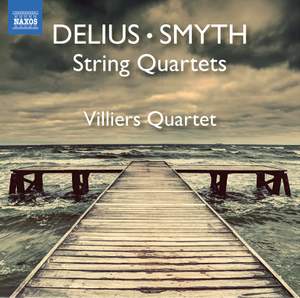DELIUS; SMYTH String Quartets
View record and artist detailsRecord and Artist Details
Genre:
Chamber
Label: Naxos
Magazine Review Date: 01/2023
Media Format: CD or Download
Media Runtime: 66
Mastering:
DDD
Catalogue Number: 8 574376

Tracks:
| Composition | Artist Credit |
|---|---|
| String Quartet |
Ethel (Mary) Smyth, Composer
Villiers Quartet |
Author: Jeremy Dibble
Among Delius’s earliest works from the late 1880s, when he was a student at the Leipzig Conservatory, was a String Quartet in C minor. Grieg’s important, large-scale Quartet in G minor, Op 27, performed in Leipzig in February 1888 while the composer was staying in the city, was almost certainly a significant stimulus and one can hear a good deal of the Norwegian’s influence in all four movements. Delius was also in touch with one of his closest fellow students, Christian Sinding, in December 1888 about having finished the work, and he sent the score to Sinding in early 1889. Sinding’s criticisms may have discouraged him from doing any further work on it, for he then decided to put it aside. The third and fourth movements of the work survived in manuscript, but the first two were thought to be lost until they surfaced at auction in 2018, at which point Daniel Grimley reconstructed the whole quartet and it received what was probably its world-premiere performance by the Villiers Quartet on October 8, 2020, in Oxford.
The opening gestures of the first movement (by far the longest of the four) have many traits – particularly elements of chromatic harmony, modality and expressive dissonances – that confirm the linguistic influence of Grieg on Delius’s early creative imagination, and Grieg’s prowess for song can be felt in the second subject. Typical of his young and ambitious temperament, the developmental phase is too long and requires more direction, but the main ideas of the exposition are appealing. Delius later reused material from the opening of the Scherzo in his 1916 Quartet, though I find this portion less attractive than the main ‘nocturnal’ body of the movement. For me the most substantial movement is the Adagio, con molta espressione, which shows just how far Delius had progressed in terms of his harmonic voice (a factor also true of his orchestral works Florida and Hiawatha). There is a real lyrical sensibility here which exhibits more control than the first movement; this trend is continued in the finale, which is engaging thematically but somewhat attenuated in terms of its structure.
Ethel Smyth’s String Quartet in E minor is a much more mature work. The first two movements date from 1902 but it was not until 1912 that the third and fourth were added. The long first movement (at almost 13 minutes) is an impressive and well-sustained essay in which Smyth’s development of material reaches a passionate zenith. My one reservation is that it is perhaps a tad too long. The lyrical dominance of the viola throughout the movement is also an intriguing and unique feature (only equalled perhaps by those viola parts of Frank Bridge, himself an aficionado of the instrument). What is more, the quartet’s viola player, Carmen Flores, is very much equal to the task of giving her generous lines lots of contrast and nuance of tone. This is also true of the big-boned, emotional slow movement, which is a fine example of Smyth’s symphonic thinking. Perhaps most engaging of all is the finale, with its bizarre fugato, arresting modulations, whole-tone scales and eccentric thematic ideas, showing the composer’s more maverick and individual demeanour. Full marks to the Villiers Quartet for bringing this new and challenging repertoire to life.
Discover the world's largest classical music catalogue with Presto Music.

Gramophone Digital Club
- Digital Edition
- Digital Archive
- Reviews Database
- Full website access
From £8.75 / month
Subscribe
Gramophone Full Club
- Print Edition
- Digital Edition
- Digital Archive
- Reviews Database
- Full website access
From £11.00 / month
Subscribe
If you are a library, university or other organisation that would be interested in an institutional subscription to Gramophone please click here for further information.




